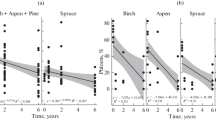Abstract
The consumption of the pine needles and the stripping of bark by sheep grazing annual pastures in three open stands of P. radiata and one of P. pinaster were measured. The P. radiata were four years old and the densities were 250, 500 and 750 trees ha-1. The P. pinaster included two, three and four year-old trees and the density was 440 trees ha−1.
Needles were eaten immediately after the sheep were admitted and this continued throughout the year. Within ten weeks of the start of winter grazing, sheep stocked at 7–10 ha−1 had eaten about half of the accessible needles on both species where densities were less than500 trees ha−1. The estimated consumption was about 260 g sheep−1 day−1 for the P. radiata. Bark stripping then commenced and continued throughout spring and summer on most plots. In some plots at low tree density, bark was stripped from more than 35% of the trees. In denser stands, needle consumption per tree was less and bark was stripped from less than 5% of the trees.
Bark damage was most common on the smaller trees, and severity of stripping was negatively correlated with tree size. Of all the trees with bark damage, 22% of the P. pinaster and 14% of the P. radiata had more than half of the stem circumference stripped. A number of these will probably suffer both stem distortion and growth retardation, and some may die.
Methods of reducing the incidence of bark damage are discussed.
Similar content being viewed by others
References
Anderson GW and Batini FE (1983) Pasture, sheep and timber production from agroforestry systems with subterranean clover sown under 15-year-old Pinus radiata by a method simulating aerial seeding. Aust J Exp Agric and Anim Husb 23: 123–130
Anon (1975) Grazing livestock among young radiata pine. NZ Forest Service, Forest Research Institute, Whats New in Forest Research, No 22
Borough CJ (1980) Agroforestry in Australia. Proceedings of Australian and New Zealand Institute of Foresters Conference, Rotorua, New Zealand
Gillingham AG, Klomp BK and Peterson SE (1976) Stock and pasture management for establishment of radiata pine in farmland. Proc NZ Grassland Assoc 37 (1):38–51
Lewis CE (1980) Simulated cattle injury to planted slash pine: Girdling-Defoliation. J Range Mgmt 33 (5), p 337- 340 and p 345–348.
Sparks DR and Malechek (1968) Estimating percentage dry weight in diets using a micro-scope technique. J Range Mgmt 21, p 264–265
Tustin JR, Knowles RL and Klomp BK (1979) Forest farming: a multiple land-use production system in New Zealand. Forest Ecology and Management 2: 169–189
Author information
Authors and Affiliations
Rights and permissions
About this article
Cite this article
Anderson, G.W., Hawke, M. & Moore, R.W. Pine needle consumption and bark stripping by sheep grazing annual pastures in young stands of widely spaced Pinus radiata and P. pinaster . Agroforest Syst 3, 37–45 (1985). https://doi.org/10.1007/BF00045737
Issue Date:
DOI: https://doi.org/10.1007/BF00045737




